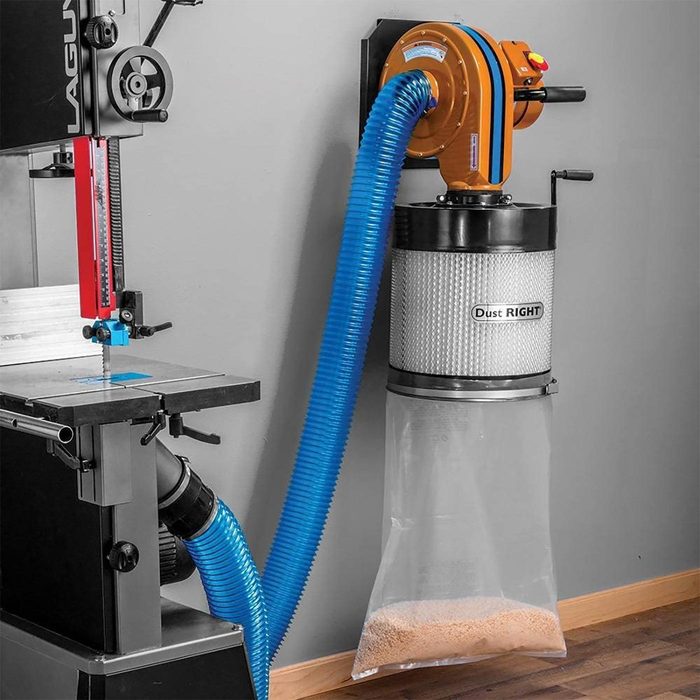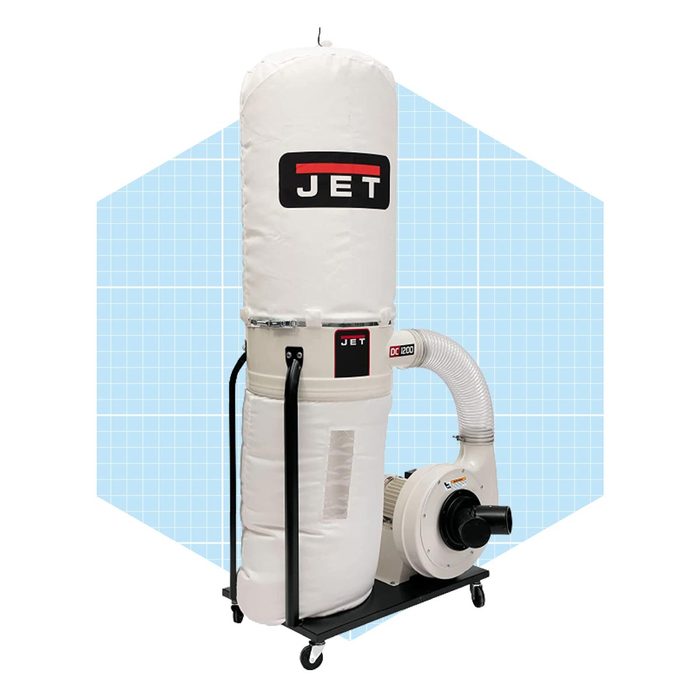 via merchant
via merchant
Best Overall
Jet Vortex Cone Dust Collector
The Jet Vortex Cone is quite popular, as evidenced by its stellar dust collection reviews. But what gives it an edge over the others and makes it the best dust collector overall? A two-horsepower motor and vortex cone technology that guarantees continuous, systematic air movement. This feature allows for better chip separation, less clogging of the filter and increased packing efficiency of the collector bag.
It takes a single-stage design approach, adding the separation efficiency of a two-stage dust collection system while still keeping the operation quiet. This machine also features a fully enclosed, fan-cooled two-horsepower motor with continuous duty, meaning there’s more than enough horsepower to make sure you’re getting efficient air movement.
The Jet Vortex boasts a collection capacity of 5.3 cubic feet and the 1,200 cfm (cubic feet per minute) stands up to its competitors. Collection bags have a sewn-in snap ring for fast and easy installation and removal. Its dual four-inch dust ports allow you to connect two machines at the same time—perfect for any workshop.
Pros
- Fan-cooled motor enables continuous usage
- Quick connect bag system
- Strong steel construction
- Four swivel casters
Cons
- Bulky
- On the heavier side
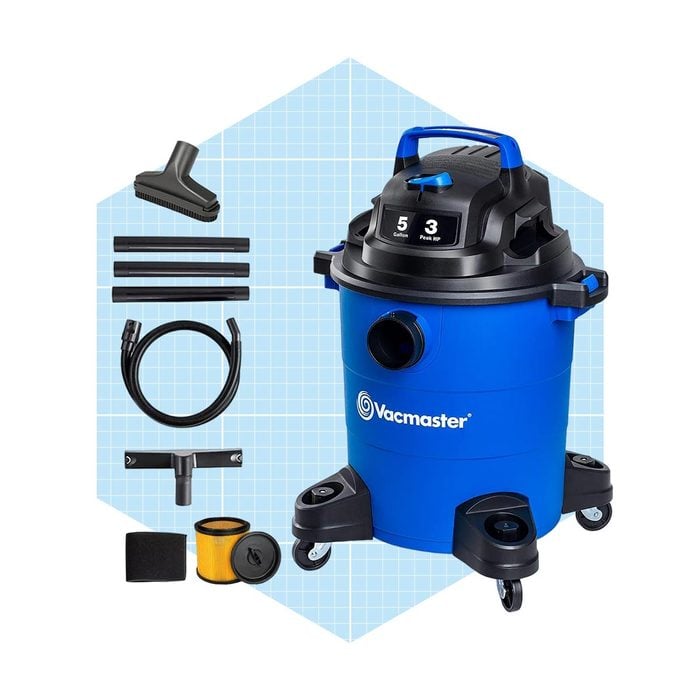 via merchant
via merchant
Best Budget
Vacmaster Wet/Dry Vac With Cyclonic Dust Bags
If you’re wondering, can wood make you sick? The short answer is yes, which is why dealing with it is so important. But if a dust collector is too costly or bulky, you can make a budget system yourself with just a few upgrades to your Vacmaster wet/dry vac. One upgrade is to add HEPA filtration to your shop vac.
When the HEPA filter and dust bag are used together, it removes 99.97% of all particles 0.3 microns and larger from the air. These dust bags look like a ring instead of the typical U-shaped bags. This allows for cyclonic airflow, meaning dust distributes more evenly throughout the bag.
Another upgrade you can make to your shop vac is with a cyclone separator. A popular one is the Dust Deputy separator, which captures about 98% of the dust in the five-gallon bucket, leaving the filter on your shop vac cleaner and running more efficiently.
Pros
- Budget-friendly
- Highly mobile and dual-purposed (wet/dry)
- Excels at capturing dust from a single tool
Cons
- Limited by its capacity, power and filtration
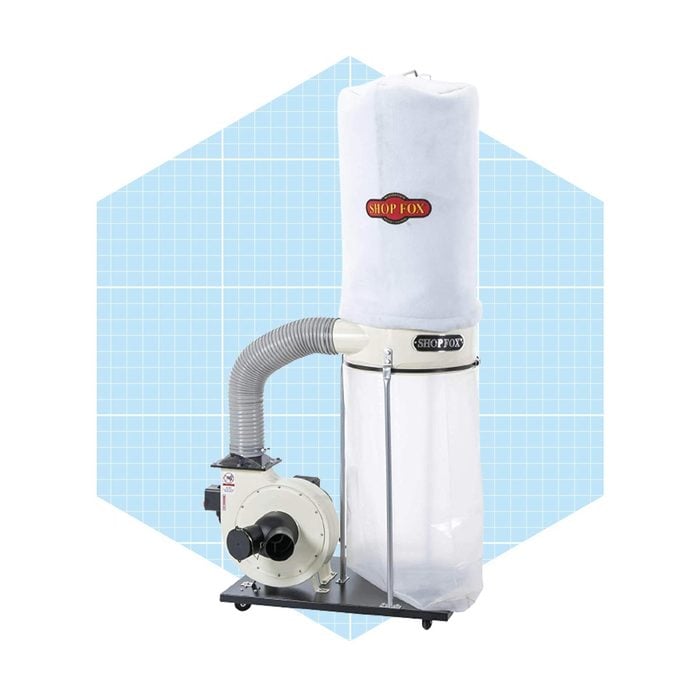 via merchant
via merchant
Best Suction
Shop Fox Dust Collector
The Shop Fox Dust Collector is portable without sacrificing horsepower. This dust collector system generates 1,280 cfm of air suction to capture dust from bigger machines. It has a 2.5-micron felt upper filtration bag, so it can defeat dust and get lots of fine particles out of the air. This unit packs a punch for its size and price range. This heavy-duty dust collection machine has powder-coated paint to prevent rust. It’s mostly steel, making it durable and strong.
It sports a steel impeller to handle the wood debris that passes through to the 2.5-micron filter bag. Unlike plastic impellers, the Shop Fox steel impeller offers long-lasting performance. It also features a removable Y-fitting and dual four-inch openings. The Y-fitting allows you to service more than one machine at a time. If you’re looking for a convenient multi-machine layout, this is the way to go.
Pros
- High suction
- Scratch-resistant coating
- Steel frame ensures durability
- Dual four-inch intake ports
- Powder dust-coated paint
Cons
- Caster wheels don’t swivel easily
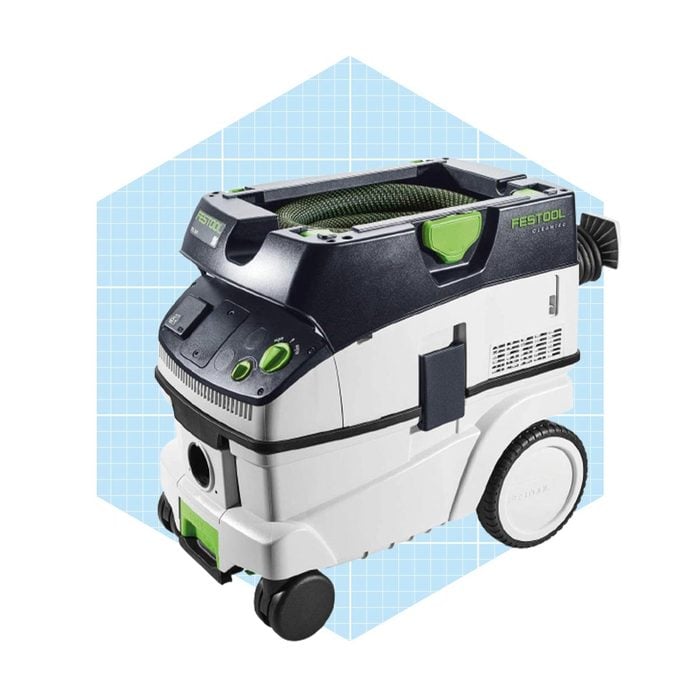 via merchant
via merchant
Best for Hand Tools
Festool HEPA Dust Extractor
The HEPA-certified Festool Dust Extractor offers the ultimate in clean air and filtration with minimal noise at only 62 decibels. It comes with a powerful motor that can produce 137 cfm and the total capacity of the dust container is just under seven gallons.
The dust collector is compatible with Festool tools, so no more swapping adapters. It’s equipped with tool-triggered auto start, so the vacuum is on only when you need it. Navigation is a breeze with extra large wheels and a parking brake to prevent unintentional roll-off or drifting.
Pros
- Compatible with Festool tools
- Impressive suction power
- Automatic turn-on feature
- Long power cord
- Low noise
Cons
- Only two of the four wheels swivel
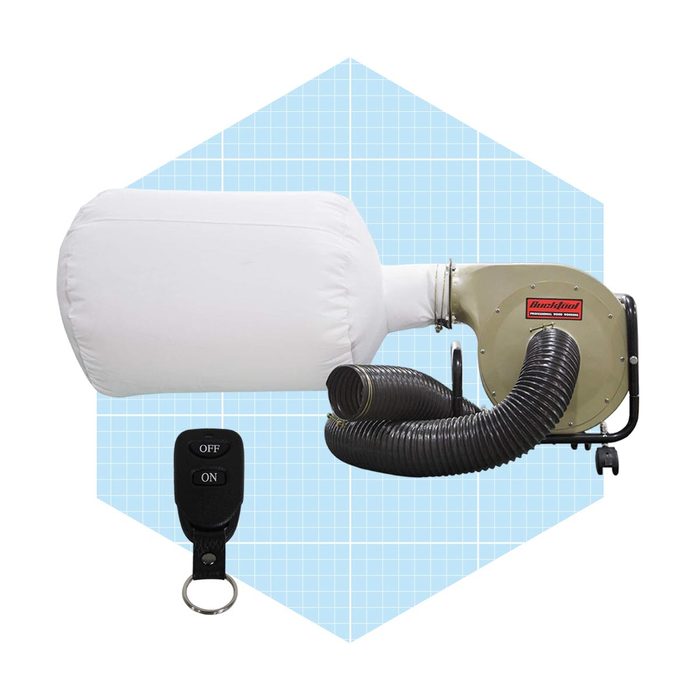 via merchant
via merchant
Most Quiet
Bucktool Wall-Mount Dust Collector
The Bucktool Wall-Mount Dust Collector is a one-horsepower unit offering 99.97% dust filtration through its one-micron canister. It’s impressively quiet with a 65-decibel rating, which allows you to work on any woodworking project in peace.
The horizontal dust chute provides optimum airflow and can swivel 180 degrees to make the four-inch outlet face downwards. It’s compact and mounts directly to the wall with remote operation. No need to store it away when finished.
Pros
- Very quiet
- Wall-mounted
- Sleek design
- Remote operation
- Easy to assemble
Cons
- Non-HEPA filter
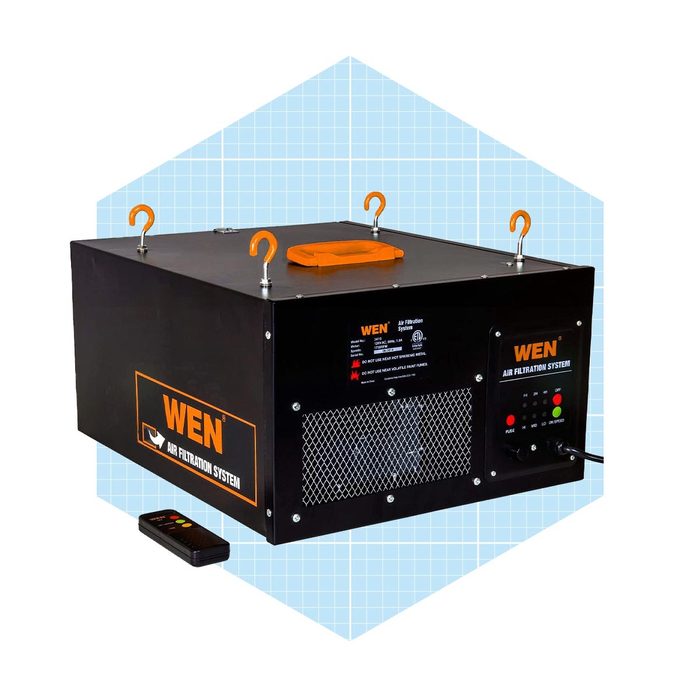 via merchant
via merchant
Best Air Scrubber
Wen Air Filtration System
The Wen multi-speed air filtration system has a strong one-sixth horsepower motor and weighs just 31 pounds. The lightweight design paired with the carrying handle and eye-bolts make this machine exceedingly portable. This Wen machine pushes air through a five-micron outer filter and a one-micron inner filter, then releases it back into the workshop.
You can choose three speeds and use the timer function to filter the air in the room at regular intervals. The Wen comes with a remote that has a range of up to 26 feet. This is the crown jewel of air scrubbers and one of the quietest on the market, emitting just 50 to 60 decibels.
Pros
- Eradicates air contaminants with two filters
- Reasonably priced
- Clear instructions and easy installation
- Quieter than expected
- Timer function
Cons
- The remote only works up to 26 feet away
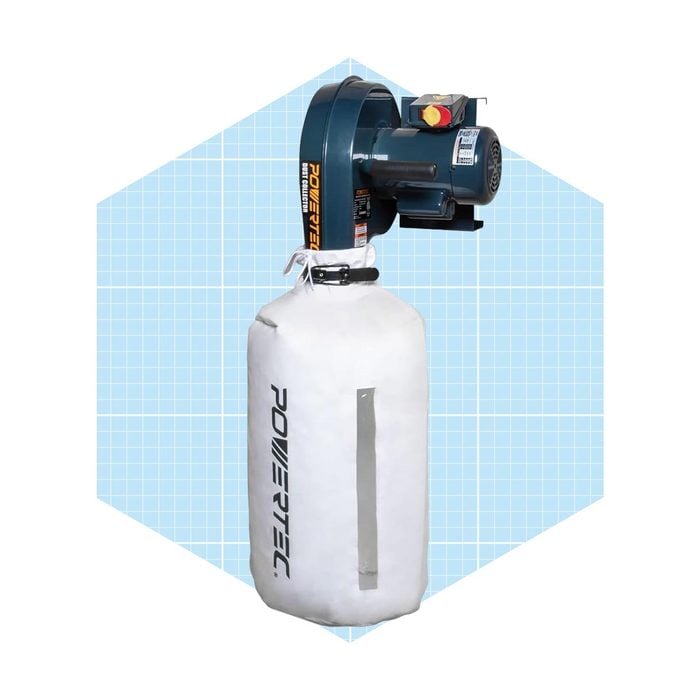 via merchant
via merchant
Best Wall Mount
Powertec Wall Mount Dust Collector
This wall-mounted dust collector has an extra small footprint, making it the perfect choice for a shop when space is at a premium. The machine moves 560 cfm of suction power through a four-inch inlet. The Dust Right operates at about 85 decibels, staying just below the harmful noise level.
Included in the kit is a one-micron bag with a clear window to see when the bag is getting full. This bag filters out the bulk of the wood dust, including fine dust.
Pros
- Mounts off the floor freeing up space
- Powerful 3450 rpm motor speed
- Compact 44-inch size
Cons
- Flexible PVC dust collection hose sold separately
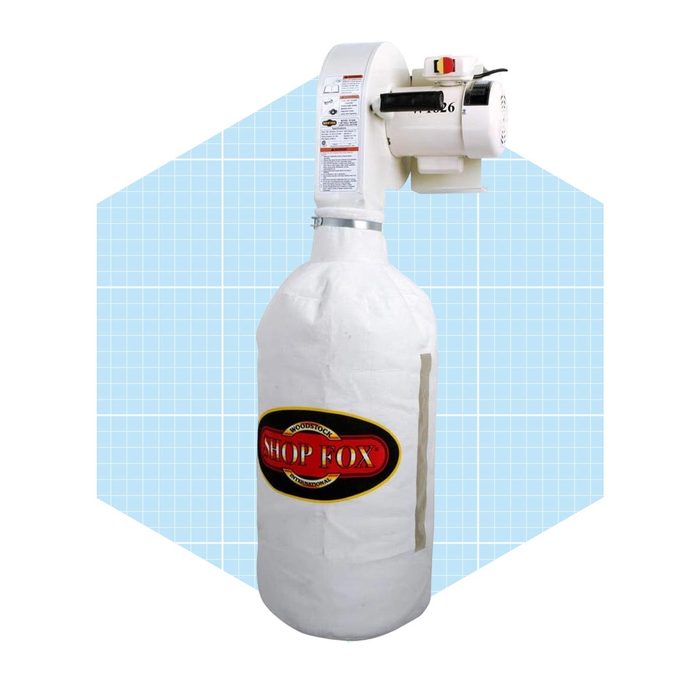 via merchant
via merchant
Best for a Small Shop
Shop Fox Wall Dust Collector
Wall dust collectors are an ideal pick for small shops. Because they mount directly to the wall rather than taking up precious floor space, they stay out of the way but still close enough at hand to use at a moment’s notice. Shop Fox’s wall dust collector is only 44 inches tall with the bag inflated, while the unit itself is only 19 inches long.
Apart from the compact size, it still boasts a powerful suction thanks to a one-horsepower motor. The included 2.5-micron filter bag filters out most contaminants, including fine dust particles. It’s a great way to keep small workshops tidy without sacrificing space.
Pros
- Zipper on the bottom for easy emptying
- Wall-mounted and compact
- 85-decibel noise is quieter than shop vacuums
Cons
- Exterior of the bag is fibrous, so dust may cling to it
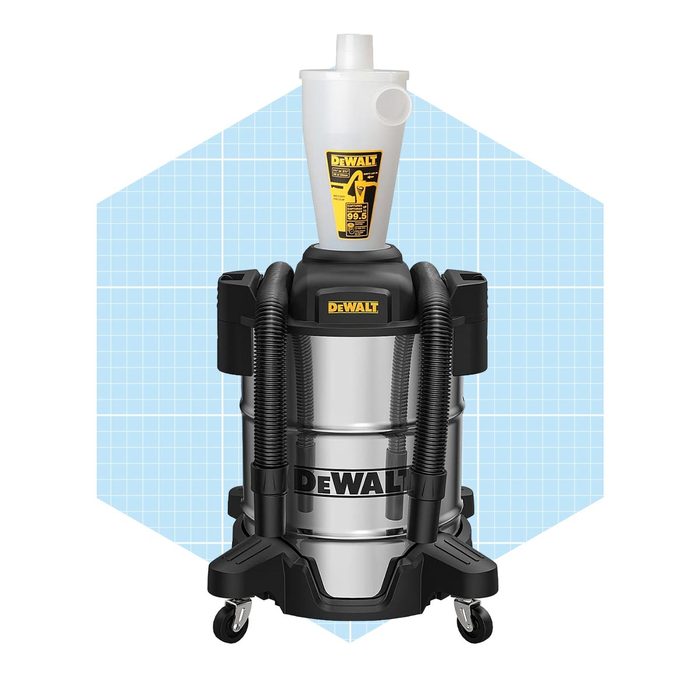 via merchant
via merchant
Best Cyclone
Dewalt Separator
When paired with a wet and dry vac, the DeWalt separator is a winning combination when it comes to defeating dust. Because it pairs with a shop vac, there’s no need to be careful about clogging the filter by sucking up non-dust particles. An adaptable port allows for a 1-7/8″ or 2-1/2″ (48 or 64mm) connection, which fits a variety of dust collection hose sizes.
The turbine airflow inside the cone effectively enhances the suction power of the shop vacuums and captures 99.5% of debris from the air stream. This eliminates suction loss and loose dust particles on the floor and in the air.
Pros
- Won’t cause suction loss
- Prevents clogged vacuum filters
- Filters out dust from wood, drywall, concrete, clay, blasting soda, soot and metal shavings
Cons
- Requires a separate wet and dry shop vacuum
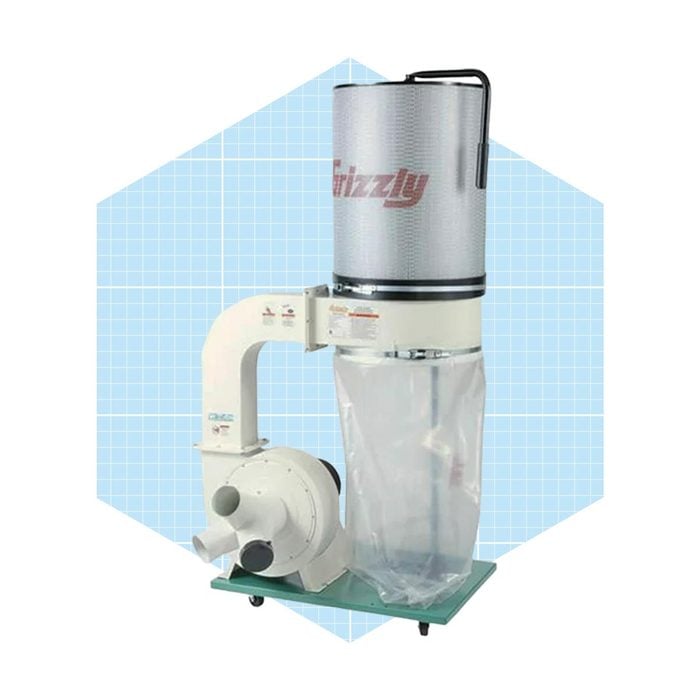 via merchant
via merchant
Best Splurge
Grizzly Dust Collector
This heavy-duty dust collector from Grizzly is best for bigger—or professional—workshops. On the exterior, the canister filter has six times the filtering area of regular bag filters thanks to the one-micron filters included. A built-in cleaning brush operates from the outside, making it so much easier than other collectors in terms of upkeep.
Simultaneously connect up to three four-inch lines using the heavy-duty steel adapter. As a bonus, it can connect directly to band saws, miter saws, planers and other types of saws for instant dust pickup. The unit ships with extra bags, all of which are clear for visibility and easy to replace when full.
Pros
- Heavy-duty steel adapter for connecting extra lines
- Built-in cleaning brush
- Easy to assemble
- Connects directly to saws
Cons
- High noise level
What to Consider When Buying a Dust Collector
Before deciding on a dust collector, it’s important to evaluate what you need. Put simply, your dust collector needs to pull more air (rated in cfm) than your most air-hungry tool (and the ductwork) requires. There are other factors to consider, like the level of air filtration and the collection bag capacity.
Folks new to woodworking (who have minimal capital to invest in large stationary tools) should consider a small portable dust collector. These portable machines are very manageable and easy to move around the shop from tool-to-tool as needed. However, you’ll sacrifice the cyclone system that separates chips and dust, resulting in more dust reaching the pleated filter. This means cleaning the filter more often.
Consider replacing stock bags with felt bags rated at five microns or less. Dust particles under 10 microns are the most harmful for your lungs and standard bags are good at capturing particles of 25 microns or bigger. Also, check the noise output to make sure it’s not too loud.
Types of Dust Collectors
“There are several different types of dust extractors,” says Lockhart. “There are stationary dust collector systems and portable dust extractors. Portable dust extractors are available as canister extractors, backpack extractors and compact extractors. Each extractor comes in a range of tank sizes and has different performance metrics (cfm and static pressure).”
“To choose the right dust extractor, the user must understand the nature of the dust they are creating, where the dust is produced and the volume of dust produced. The user must choose the appropriate dust extractor for their specific job site application based on performance needs, product features desired and any local dust regulations. The Occupational Safety and Health Administration (OSHA) standards 1926.1153 and 1910 offer guidelines for respirable crystalline silica dust and wood dust,” Lockhart notes.
The types of dust collectors are as follows:
- Shop vacs: This is an affordable option, best for smaller tools. It picks up random debris such as screws. The vacuum needs emptying more often and the filter clogs more frequently. The filtering capacity of a shop vac is not nearly as strong as a dust collector, but there are ways to improve it.
- Dust extractors: These collect dust from handheld power tools. Dust extractors, like the Festool HEPA version, can be extraordinarily quiet with a tool-activated switch that turns the extractor on automatically.
- Single-stage dust collectors: Two-bag, single-stage dust collectors work by transporting sawdust and wood chips through an impeller on the way to a collection bag. The heavier particles and debris then settle in the lower bag. It’s a simple design with a higher horsepower output that lets you connect to larger tools like a table saw or planer. They come in various designs: upright, wall-mounted or handheld.
- Cyclonic canister dust collectors: This type has a higher airflow and two-stage dust separation, separating smaller dust particles from larger pieces. As a result, the finer dust particles pass through the impeller and into the filter. The canister filter is excellent at capturing one-micron and two-micron dust particles effectively.
Why You Should Trust Us
As a woodworker, I have years of experience educating and crafting in my home shop. Every piece featured on my site is handmade in my woodworking shop.
Emily Way is an associate shopping editor for Family Handyman with experience researching products and recommending the best designs to consumers. She researched and updated this piece, carefully to ensure price, reviews and quality all speak to the value of each pick and that each selection reflects the quality that we’d want to see in our own workshops.
Way consulted Heather Lockhart, product manager with DeWalt overseeing the vacuum and dust extractor categories. Lockhart develops strategic product plans for the Global Tools and Storage team, including managing product roadmaps and future innovation.
How We Found the Best Dust Collector
As woodworkers and DIY enthusiasts, our goal is to bring you the best of the best when it comes to furnishing your home shop. We looked through the available machines on the market, using our woodworking knowledge to narrow down our list to the top 20 machines. Then, we combed through airflow charts, decibel levels, types of dust collectors and static pressure loss calculations. The result? The 10 best dust collectors, ranked by their best applications.
FAQ
How big of a dust collector do I need?
Cubic feet per minute (cfm) and horsepower are two essential features to consider when understanding how big of a dust collector you need. Horsepower determines how strong the dust collector motor is and the cfm is the amount of airflow the collector generates.
Medium-sized dust collectors are typically around one horsepower and 700 cfm. If your workshop has two or three power tools, then a one-horsepower, 700 cfm dust collector is the smartest choice. Larger shops with multiple stationary power tools should use collectors that are around 1.5 horsepower with 1,200 cfm.
How does a dust collector work?
Dust collectors have high airflow and low suction, which is why the hose picks up lighter sawdust. However, it can’t pick up large pieces like screws. The dust collector’s motor drives an impeller fan that generates a large volume of airflow that moves dust and debris from woodworking tools. There are many types of dust collectors, but they all have a larger hose than shop vacs and a more powerful motor.
Is a dust collector better than a shop vac?
Use a shop vac for general cleanup. It keeps surfaces clear of sawdust—but not the air. If your smaller tool has a two-inch or smaller dust port, a shop vac is adequate. A larger tool like a table saw, jointer or planer creates a large amount of wood chips and quickly overwhelms a shop vac.
Lockhart notes that, “All dust extractors are vacuums, not all shop vacuums are dust extractors. A shop vacuum is more durable than the common household vacuum and is used to handle dust, heavier debris or wet cleaning applications. A dust extractor is designed to handle higher volume dust production than a common shop vacuum.”
“They have higher quality filters, often HEPA filters, and an automatic filter cleaning feature to prevent fine dust build-up and clogging on the filters. To contain the dust, dust extractors can connect directly to the dust port of a specific tool or use a shroud to help contain dust and debris created from the tool.” Those unsure about what type of tool they need should have their needs covered by opting for a dust collector. “Cleaning accessories can be purchased, and dust extractors can be used for cleanup, just like a shop vacuum,” she says.
Dust collectors move higher quantities of air than shop vacs, catching the finer dust particles in the filter, so use them specifically in wood shops. Dust collectors handle significantly more sawdust quicker and experience less drop-off in performance further away from the source because of the greater volume of air it’s moving.

